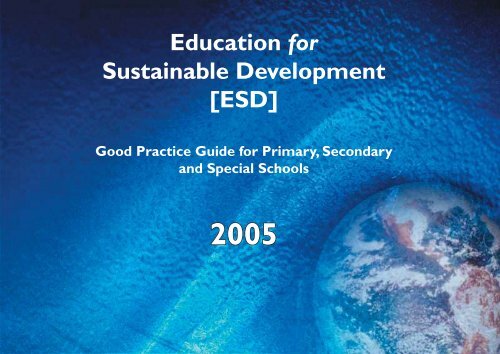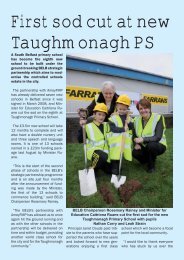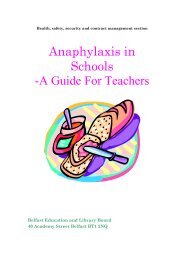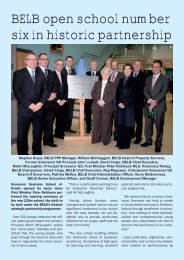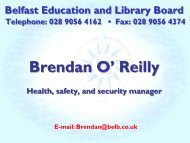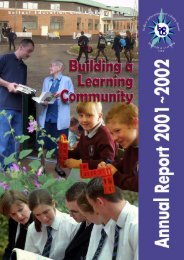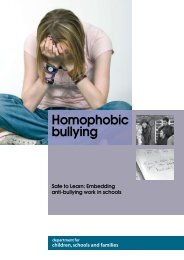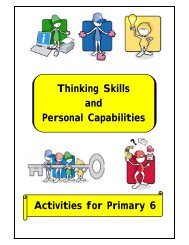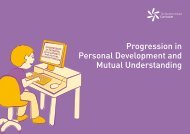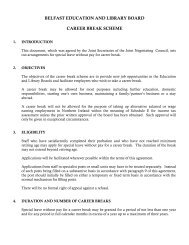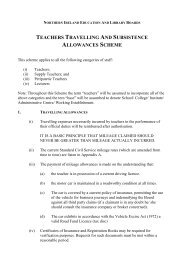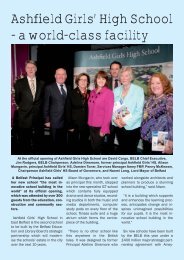Good Practice Guide
Good Practice Guide
Good Practice Guide
Create successful ePaper yourself
Turn your PDF publications into a flip-book with our unique Google optimized e-Paper software.
Education for<br />
Sustainable Development<br />
[ESD]<br />
<strong>Good</strong> <strong>Practice</strong> <strong>Guide</strong> for Primary, Secondary<br />
and Special Schools<br />
2005
Acknowledgements<br />
Holistic<br />
The Interboard ESD group would like to acknowledge the contribution of Cross-Phase Curriculum<br />
Advisory and Support Offi cers from various specialist areas such as Literacy, Numeracy and Information<br />
Technology in the compilation of this document.<br />
We would also like to thank:<br />
• Cambridgeshire Environmental Education Service and Cambridgeshire Advisory Service;<br />
• Dr Stuart Nundy, Outdoor Activities Offi cer for Hampshire, Chairman of the National Association<br />
of Field Study Offi cers;<br />
• National Association of Field Study Officers (NAFSO) for their guidance on Quality, Safety and<br />
Sustainability in the delivery of Learning through the Environment www.nafso.org.uk ;<br />
• Justin Dillon, King’s College, London, nfer report “Engaging and Learning with the Outdoors”,<br />
April 2005;<br />
• Dr Peter Higgins, Head of Outdoor Education at Moray House Institute, the School of Education<br />
of the University of Edinburgh www.education.ed.ac.uk ;<br />
• Dr Dave Riley and Dr Michael Cross, WELB CASS based at Magilligan Field Centre,<br />
www.welb-cass.org/mfc;<br />
• Suzette Butler, former Science Field Offi cer with BELB;<br />
• The Interboard Energy and Environment Offi cers;<br />
• Staff at WELB Reprographics Section, Omagh.<br />
for their guidance in raising achievement, promoting understanding and encouraging participation in<br />
ESD within a School Improvement Programme.<br />
1
Compelling<br />
FOREWORD<br />
Sustainable Living<br />
As a fi fth generation member of my family to be entrusted with the farm I am indebted to<br />
my ancestors whose sustainable legacy I’m continually building upon. To ensure that my farm<br />
business becomes truly sustainable I’m always looking at ways in which I can reduce my business’s<br />
environmental footprint.<br />
This personal educational process for learning about sustainable living has now become a life-long<br />
one which has a compelling future.<br />
The 6 Key<br />
Issues of the<br />
Sustainable<br />
Development<br />
Strategy for N I<br />
1.<br />
2.<br />
3.<br />
4.<br />
5.<br />
6.<br />
Climate Change &<br />
Energy<br />
Sustainable<br />
Consumption and<br />
Production<br />
Natural Resource<br />
Protection<br />
Sustainable<br />
Communities<br />
Sustainable<br />
Governance<br />
Learning and<br />
Communication<br />
Sustainable Development<br />
At present in Northern Ireland our consumption rate is 3.5 times greater than the replenishment<br />
of our natural resources. This current behaviour is unsustainable at all levels - individually, locally,<br />
nationally and internationally. Social, economic and environmental issues related to this behaviour<br />
are inextricably linked and potentially complex.<br />
The Northern Ireland Sustainable Development Strategy will endeavour to address these issues by<br />
infl uencing Government Policy.<br />
Education for Sustainable Development - ESD<br />
Learning and communication lie at the heart of approaches to Sustainable Development. Our<br />
future lies in the education of our next generation in the true meaning of sustainable development.<br />
We need a sustainability literate and globally aware workforce. They are our ambassadors and<br />
innovators of the future with the potential to embrace new sustainable technologies.<br />
2
The revised Northern Ireland curriculum will embed the concept of sustainable development<br />
into the curriculum at all levels with an emphasis on demonstrating and achieving the positive<br />
behavioural change required to live more sustainably.<br />
Future<br />
The Education for Sustainable Development progression framework shows how this can be<br />
achieved in primary schools. Through environmental sustainability awareness raising in the ‘World<br />
Around Us’; in secondary schools through the ESD sections of a variety of subjects but primarily<br />
Citizenship, Geography and Science. ESD is seen as a ‘process’ of learning how to make decisions<br />
that consider the long term future of the ecology, economy and equity of all communities both<br />
locally and globally.<br />
In my part, as the N. Ireland Sustainable Development Commissioner it has been a privilege to be<br />
asked to write this foreword and I commend this document to you, the N.I. teaching profession.<br />
These guidelines will give you insight to where your contribution in a child’s ESD journey<br />
contributes to their destination in sustainable living. A compelling future for Northern Ireland.<br />
John Gilliland OBE<br />
N. Ireland Sustainable Development Commissioner<br />
3
Innovative<br />
Introduction<br />
Sustainable development is the fundamental challenge that all societies face if we are to avoid longterm<br />
damage to the Earth’s basic life-support systems. In response to this challenge UNESCO has<br />
designated 2005 - 2014 as the Decade of Education for Sustainable Development (DESD). The basic<br />
vision of the DESD is a world where everyone has the opportunity to benefit from quality education<br />
and learn the values, behaviour and lifestyles required for a sustainable future and for positive societal<br />
transformation.<br />
Concern for the environment is the responsibility of everyone and education has an important role<br />
to play. Research shows that young people care about their future and the world in which they live.<br />
They need to learn to live in ways that improve the quality of life for themselves and others without<br />
endangering or depleting the Earth’s resources.<br />
Education for Sustainable Development (ESD) in Northern Ireland has evolved out of Environment<br />
Education and Development Education ideas and has links to personal, social, economic and citizenship<br />
issues. ESD is seen as a process of learning how to make decisions that consider the long term future<br />
of the ecology, economy and equity of all communities. Sustainability is about improving the quality of<br />
people’s lives and surroundings without destroying the life supporting systems on which current and<br />
future generations depend. There are seven key concepts which underpin ESD.<br />
1. Citizenship and stewardship<br />
2. Sustainable change<br />
3. Needs and rights of future generations<br />
4. Interdependence<br />
5. Diversity<br />
6. Uncertainty and precaution<br />
7. Quality of life, equity and justice<br />
For details on each of the above see Appendix 1.<br />
4
ESD is relevant to everyone at whatever stage of life they find themselves. It takes place therefore<br />
within the context of lifelong learning in a variety of educational settings both formal and informal.<br />
ESD can help pupils develop understanding, skills and values and empower them to make a difference.<br />
One of the aims of ESD is to encourage learners to become active citizens in relation to Sustainable<br />
Development Issues on both a local and global scale.<br />
Awe<br />
Sustainable<br />
Living<br />
The aspirational outcome of Sustainable Living is built<br />
upon a strong foundation of Environmental Sustainability<br />
Awareness.<br />
Sustainable<br />
Development<br />
Education for<br />
Sustainable Development<br />
Environmental Sustainability<br />
Awareness<br />
Figure 1<br />
Education for Sustainable Development teaches<br />
about the complexity of holistic systems which support<br />
behavioural change, ownership and connection with the<br />
environment.<br />
Sustainable Development develops through<br />
informed choices and concern for the quality of life<br />
for all in both a local and global context engendering<br />
responsibility.<br />
However, it is only by taking active participation<br />
that students will learn from first hand<br />
experiences of their own environment that they<br />
personally can make a difference and that by<br />
doing so they begin to care.<br />
Sustainable Living will only occur when ‘consistent messages’ are embedded by actively working<br />
through the 5 circles of taking responsibility – see Appendix 2.<br />
5
Fun<br />
Revised Curriculum<br />
ESD is a statutory element of the revised curriculum for NI. The Northern Ireland Curriculum aims<br />
to empower young people to achieve their potential and to make informed and responsible decisions<br />
throughout their lives as contributors to the economy and to the environment. (CCEA 2003).<br />
ESD is an important element of the curriculum because it promotes understanding of the world<br />
around us, from local to global, and of the need to make lifestyle decisions, which allow us to<br />
maintain and improve the quality of our lives today without compromising the quality of life of future<br />
generations. ESD facilitates access to, and encourages active participation in environment and<br />
development education activities at all levels, from the classroom and school grounds to the local<br />
area and further afi eld.<br />
Education Outside the Classroom<br />
Outdoor Education contributes to learning in a range of areas including: Science and Geography<br />
fi eldwork; Physical Education; learning through Outdoor Play, particularly in the Early Years; History<br />
and Citizenship, through visits to museums and heritage sites; Art and Design, through visits to<br />
galleries and experiences of the built environment; Environmental and Countryside Education and<br />
Education for Sustainable Development; practical or vocational skills that cannot be practised in a<br />
classroom environment; group activities that build self-confidence and social skills; and the use of the<br />
environment as a tool to enrich the curriculum across subject areas. (House of Commons Education<br />
and Skills Committee 2005, p.6)<br />
To use an Outdoor Classroom ‘setting’ effectively then specifi c Outdoor Learning ‘outcomes’ will<br />
be achieved through the well managed ‘process’ of Outdoor Education. These targeted Outdoor<br />
Learning outcomes will have signifi cant benefits to students if followed up back in the classroom and<br />
integrated into schoolwork. Academic fieldwork clearly enhances the teaching of Geography and<br />
Science, but other subjects such as History, Art & Design and Citizenship can also be brought to life<br />
by high quality, safe and sustainable educational visits.<br />
The N. Ireland Educational Visits Policy, <strong>Practice</strong> and Procedures gives clear, concise information on<br />
the management of the Health and Safety of Pupils on Educational Visits. It can be downloaded from<br />
www.welb-cass.org/mfc – school support section.<br />
6
School Improvement Programme<br />
A whole school commitment, led by senior managers to integrate ESD into every aspect of school life<br />
could be achieved by incorporating the school ESD Self–Evaluation and Quality Assurance checklists<br />
into the school development plan as part of any visionary School Improvement Programme.<br />
To summarise ESD is concerned with:<br />
• Improving knowledge and understanding ABOUT the environment and development issues.<br />
• Offering fi rst hand experience IN the environment and development issues.<br />
• Developing skills THROUGH the environment and development issues.<br />
• Encouraging informed concern and action FOR the environment and development issues.<br />
Developing and implementing a strategy for education<br />
for sustainable development is a major challenge and<br />
opportunity for all schools.<br />
“Developing and<br />
implementing<br />
a strategy for<br />
education for<br />
sustainable<br />
development<br />
is a major<br />
challenge and<br />
opportunity for<br />
all schools<br />
”<br />
7
Caring<br />
The remainder of this document is divided into sections covering:<br />
• Starting Points for an ESD School Policy<br />
• ESD checklist for school self-evaluation<br />
• ESD quality assurance checklist<br />
• ESD progression: Foundation stage to Key stage 4 a classroom teacher’s guide<br />
It is intended that schools will work towards transformation into sustainable communities in every<br />
aspect of school life. Young people will then be able to share the lessons and values learned on<br />
sustainability in their everyday lives in their local communities.<br />
A review or audit of current practice is an essential starting point for the development of any new<br />
policy. The following summary provides both a checklist for auditing current practice and starting<br />
point for the development of a policy.<br />
An ESD policy should include for each of the key areas below:<br />
• A statement of current practice<br />
• Future plans with specified targets<br />
• Time scale for implementation<br />
• Resource requirements and sources<br />
• Responsibility<br />
• Monitoring, evaluation and review<br />
8
ESD Checklist for School Self-Evaluation<br />
Wonder<br />
1. The school’s ethos and values refl ect a concern for the local and global environment and for<br />
sustainable development.<br />
2. Systems are in place to ensure the involvement of the whole school community in ESD e.g.<br />
through a school council or eco-committee.<br />
3. There is a whole school ESD policy, incorporating an action plan, which contributes to pupils’<br />
spiritual, moral, social, personal and physical development.<br />
4. There is a nominated member of staff to co-ordinate the school policy and action plan.<br />
5. Is ESD used effectively for curriculum enrichment (See progression guidance)<br />
• Is there a balance of ESD work through the year groups and across the General Learning<br />
Areas<br />
• Is there progression and continuity cross-phase<br />
• Is there progression in the development of knowledge and understanding about the<br />
environment and of attitudes and values for the environment<br />
(e.g. The Pushkin Trust www.pushkinprizes.org.uk)<br />
• Is there a programme of curricular activities in the environment and skills development<br />
through the environment (e.g. N. Ireland Ecotrails http://www.ecotrails.co.uk/ and<br />
Education Outside the Classroom programmes)<br />
• Does it include fieldwork in school grounds, local and more distant environments, and is<br />
residential experience offered<br />
6. Teachers recognise that pupils’ ESD entitlement depends on fi rst hand experiences.<br />
7. The school takes part in environment and Healthy Living initiatives and participates in<br />
international schemes such as the European wide Eco-Schools www.eco-schools.org.uk<br />
(an Environment Management Audit System) scheme.<br />
8. Schools should adopt principles and practice as outlined in <strong>Good</strong> <strong>Practice</strong> <strong>Guide</strong> 343 “Saving<br />
Energy - A Whole School Approach” as part of the N.I. Schools Turnkey Energy Project.<br />
(ELB Energy Efficiency Officer) www.thecarbontrust.co.uk/energy/pages/page_236.asp<br />
9
Community<br />
9. There is a conservation plan for managing the whole school site.<br />
Are the school grounds imaginatively and attractively designed Are the grounds managed<br />
well, used well and cared for Are pupils involved in the development and care of their grounds<br />
Is there a management and development plan for the grounds<br />
(e.g. Learning Through Landscapes www.ltl.org.uk)<br />
10. The school purchases environmentally friendly products, recycles used materials and promotes<br />
effective waste management.<br />
11. The school is attempting to address the pollution, health and safety risks caused by travelling to<br />
school by car.<br />
12. Displays, newsletters and assemblies refl ect the school’s environment and development initiatives<br />
and both staff and pupils’ awareness and involvement.<br />
13. Is the school well resourced for environment work Is there a supply of appropriate books,<br />
ICT equipment, fi eld studies equipment and other learning and teaching materials<br />
14. The school belongs to local / national environmental and developmental organisations.<br />
(Council Environment Education officer).<br />
15. There are opportunities in the school development plan for staff and governor training in<br />
Education for Sustainable Development.<br />
16. Have subject leaders identified opportunities within their schemes of work to enable ESD to be<br />
delivered and reinforced through the curriculum<br />
Does the teaching approach promote active learning to develop pupil’s understanding of<br />
sustainable development<br />
17. What links has the school established to support and develop a local and global dimension<br />
within the curriculum<br />
18. How does the school involve, make use of, the wider school community to enrich learning and<br />
pupils’ personal and social development including the effective use of business, local authorities,<br />
non-government organisations and community groups to support their work in developing the<br />
sustainable agenda<br />
10
ESD Quality Assurance Checklist<br />
Connection<br />
Education for Sustainable Development provision is good when:<br />
Management – focusing on<br />
the school mission statement;<br />
ESD policy statement;<br />
senior management involvement and support;<br />
references in the school development plan;<br />
allocation of resources;<br />
role of the governing body;<br />
guidance on implementation into the curriculum;<br />
relevant professional development;<br />
ESD audit;<br />
monitoring of ESD;<br />
the sustainability of ESD projects.<br />
Curriculum – focusing on<br />
planning;<br />
inclusion and identifi cation within current schemes of work and lesson planning;<br />
evidence of cross-curricular mapping.<br />
bias-free resources with no stereo-types.<br />
11
Shared Values<br />
Teaching – focusing on<br />
positive role models;<br />
use of local case studies;<br />
engaging local issues;<br />
links with, and use of Education for Sustainable Development associations;<br />
use of topicality;<br />
active learning;<br />
exploring issues leading to action on behalf of pupils;<br />
evidence in displays of work, for example, letters to decision makers;<br />
global links;<br />
fi eld visits.<br />
Learning – focusing on<br />
independent styles of learning;<br />
children developing their own reasoned points of view;<br />
pupils as active citizens within the classroom, school and community;<br />
active participation in reducing waste;<br />
active decision-making.<br />
Decision-making – focusing on<br />
active involvement in a school or eco-committee;<br />
examples of whole school participation and cooperation;<br />
playground committee;<br />
active environmental group;<br />
networking and community involvement;<br />
fundraising;<br />
feedback mechanisms for students to talk about school issues;<br />
pupil-parent-teacher working groups.<br />
12
Specific projects – focusing on<br />
details of specifi c initiatives the school may be involved in;<br />
links with Non Government Organisations or other areas of funding and support;<br />
details of each project context, funding, success indicators.<br />
Joy<br />
General environmental indicators – focusing on<br />
an eco-code;<br />
waste minimisation and recycling schemes managed by pupils;<br />
incentives and schemes in place for staff and pupils e.g. to travel by means other than a car.<br />
Purchasing – focusing on<br />
recycled paper;<br />
Fair Trade products;<br />
fresh food on offer;<br />
local produce sourcing policy;<br />
environmentally friendly purchasing throughout the school;<br />
energy efficiency measures in place;<br />
pupils involvement in purchasing policy.<br />
Grounds and Learning Environment - focusing on<br />
the use of school grounds and facilities;<br />
wildlife garden;<br />
use and upkeep of green space;<br />
nature set aside areas;<br />
recycling facilities;<br />
use of school grounds for teaching and enhancing the taught curriculum;<br />
diversifi cation of school buildings and grounds outside school hours for example for community<br />
education.<br />
Reference: ESD Guidance Inspection checklist<br />
Source Ofsted HMI 1658 “Taking the fi rst step forward…towards an education for sustainable development”<br />
October 2003.<br />
13
Progression in ESD: FOUNDATION STAGE<br />
KNOWLEDGE &<br />
UNDERSTANDING ABOUT THE<br />
ENVIRONMENT<br />
SKILLS FOR EDUCATION IN THE<br />
ENVIRONMENT<br />
ATTITUDES & VALUES FOR<br />
THE ENVIRONMENT<br />
LITERACY, NUMERACY AND ICT<br />
THROUGH THE ENVIRONMENT<br />
By the end of Year 2 most pupils<br />
should<br />
• be interested in and curious about<br />
their local environment recognise/<br />
talk about features in their school<br />
grounds<br />
• know that there are different<br />
kinds of animals & plants in the<br />
local environment name and draw<br />
some plants & animals in the school<br />
grounds<br />
• begin to recognise change in the<br />
local environment record changes in<br />
the weather using a weather chart/<br />
diary<br />
• know that there are differences<br />
between environments recognise<br />
that there are different plants &<br />
animals in the school grounds and<br />
another habitat e.g. seaside<br />
• begin to recognise that they depend<br />
on each other e.g. children, friends,<br />
staff, caretaker<br />
• know how their actions can<br />
improve or change their<br />
environment planting seeds or bulbs<br />
in school grounds<br />
By the end of Year 2 most pupils<br />
should be able to<br />
• ask & respond to questions about the<br />
environment. What could the children<br />
do to help birds in school grounds e.g.<br />
bird food, bird bath.<br />
• explore aspects of the environment<br />
using their senses use a variety of trails<br />
in school grounds e.g. sensory, colour,<br />
material.<br />
• record what they have seen or found<br />
drawing, digital photos<br />
• talk about their work & explain what<br />
they have found out/done why is there<br />
more litter in the school grounds after<br />
break and lunchtime<br />
• investigate a simple issue in their<br />
school life e.g. transport to/from school;<br />
healthy living; school grounds; litter<br />
• acquire skills necessary to keep safe<br />
in familiar/unfamiliar environments e.g.<br />
washing hands after handling plants and<br />
animals, knowing that some plants can<br />
be poisonous.<br />
health & safety skills:<br />
www.cleapps.org.uk<br />
By the end of Year 2 most pupils<br />
should<br />
• be able to talk about things they<br />
like/don’t like about their local<br />
environment looking for ‘nice’ and<br />
‘nasty’ places in school grounds.<br />
• show respect and care for plants<br />
& animals handle mini-beasts<br />
gently, e.g. Forest schools.<br />
• identify ways of improving their<br />
local environment putting litter in<br />
the correct bins, not pulling fl owers.<br />
• talk about the consequences of<br />
some of their actions dropping<br />
litter in classroom, playground.<br />
• have begun to realise that basic<br />
needs such as clean water and<br />
food are universal e.g. Blue Peter<br />
appeals.<br />
Literacy<br />
• Text level – Write simple labels/<br />
questions for photos of features in<br />
school grounds.<br />
• Sentence level – Write simple<br />
sentences about their favourite place<br />
in the school grounds.<br />
• Word level – Make a collection of<br />
words linked to scavenger hunt.<br />
Numeracy<br />
• Measures – Order three objects<br />
according to size, weight and length.<br />
Estimate the length of objects using<br />
arbitrary units.<br />
• Handling data – Sort for one<br />
criterion using diagrams such as<br />
Carroll, Venn, Tree. Understand/<br />
explain what a given pictograph/block<br />
graph represents.<br />
ICT<br />
• Communication – Compose simple<br />
sentences on screen through the use<br />
of the keyboard / word-banks.<br />
• Information handling – Use a<br />
simple graphing package to create<br />
a minibeast pictogram. With<br />
assistance, enter information into a<br />
prepared database e.g. colours, minibeasts.<br />
Use a CD Rom to fi nd out<br />
information.<br />
14
Progression in ESD: Key Stage 1<br />
KNOWLEDGE & UNDERSTANDING<br />
ABOUT THE ENVIRONMENT<br />
SKILLS FOR EDUCATION IN THE<br />
ENVIRONMENT<br />
ATTITUDES & VALUES FOR<br />
THE ENVIRONMENT<br />
LITERACY, NUMERACY AND ICT<br />
THROUGH THE ENVIRONMENT<br />
By the end of Year 4 most pupils should<br />
• recognise that similarities and<br />
differences among plants & among<br />
animals in the local environment -<br />
record differences between bird’s feet<br />
and beaks.<br />
• know that plants and animals can be<br />
sorted into groups using observable<br />
features - identify trees in school<br />
grounds which lose /do not lose their<br />
leaves in winter.<br />
• recognise that environments change<br />
naturally and because of human<br />
infl uence - seasonal weather change<br />
and waste minimisation.<br />
• know that there are differences between<br />
environments and that these affect<br />
which animals and plants are found<br />
there - name some plants and animals<br />
they expect to fi nd in school grounds<br />
and another habitat e.g. seaside.<br />
• Begin to recognise that living things<br />
depend on each other - naming animals<br />
that eat other animals and animals that<br />
only eat grass.<br />
• know how people’s actions can improve<br />
or damage the environment - cutting<br />
down trees/taking away the hedgerow<br />
habitat e.g. berries and nests.<br />
By the end of Year 4 most pupils<br />
should be able to<br />
• ask relevant questions about the<br />
environment based on experience<br />
- what is it, where is it, why is it there,<br />
who caused it, when did it happen<br />
• explore and investigate aspects of<br />
their own environment - examine<br />
signs of growth in school border.<br />
• record what they have done or<br />
observed using appropriate methods<br />
- use a simple table to record results.<br />
• draw conclusions from their results<br />
- that there are different types of litter<br />
in the school grounds.<br />
• investigate a simple issue in their<br />
local environment - transport;<br />
healthy living; school grounds; litter.<br />
• acquire skills necessary to keep safe<br />
in familiar/unfamiliar environments -<br />
wash hands after handling plants and<br />
animals, knowing that some plants<br />
can be poisonous.<br />
health and safety skills:<br />
www.cleapps.org.uk<br />
By the end of Year 4 most pupils<br />
should<br />
• begin to give reasons for their<br />
own likes and dislikes about the<br />
environment - explain why they<br />
like to visit the sensory garden<br />
in the school grounds.<br />
• appreciate / value the variety<br />
of animals and plants, locally<br />
and globally - encouraging<br />
biodiversity in the school<br />
grounds e.g. bird and bat boxes.<br />
• take action to improve their<br />
school environment - planting to<br />
encourage wildlife in the school<br />
ground.<br />
• begin to take responsibility<br />
for the consequences of their<br />
actions - suggesting ways of<br />
reducing; reusing and recycling<br />
at school.<br />
• begin to recognise that basic<br />
needs are universal - being<br />
aware of an environmental<br />
issue overseas<br />
e.g. Blue Peter appeal.<br />
Literacy<br />
• Text level – Write simple nonchronological<br />
reports from known<br />
information.<br />
• Sentence level – Use a widening<br />
range of conjunctions e.g. if, so,<br />
while, through, since, when.<br />
• Word level – Use independent<br />
spelling strategies such as word<br />
banks, dictionaries.<br />
Numeracy<br />
• Measures – Use different parts of<br />
the body to measure length. Begin<br />
to use metre as a standard unit.<br />
• Handling data – Sort for two criteria<br />
using diagrams such as Carroll,<br />
Venn, Tree/classifi cation package.<br />
Represent data from a frequency<br />
table on a block graph and interpret<br />
results.<br />
ICT<br />
• Communication – Use a word<br />
processor to write creatively in a<br />
variety of forms e.g. poems, stories,<br />
and reports.<br />
• Information handling – Use a<br />
simple graphing package (bar<br />
graph). Use a simple database<br />
to search data on one criterion.<br />
Access information from a variety of<br />
software/CD-ROMs.<br />
15
Progression in ESD: Key Stage 2<br />
KNOWLEDGE & UNDERSTANDING<br />
ABOUT THE ENVIRONMENT<br />
SKILLS FOR EDUCATION IN THE<br />
ENVIRONMENT<br />
ATTITUDES & VALUES FOR<br />
THE ENVIRONMENT<br />
LITERACY, NUMERACY AND ICT<br />
THROUGH THE ENVIRONMENT<br />
By the end of Year 7 most pupils should<br />
• recognise similarities & differences<br />
amongst plants and animals in<br />
different habitats - record similarities &<br />
differences between birds in the school<br />
grounds and birds at the water margins<br />
• know how local plants and animals<br />
can be identifi ed and grouped - using<br />
simple keys identifying plants and<br />
animals found in the school grounds<br />
using a simple key<br />
• recognise ways in which animal and<br />
plant behaviour is infl uenced by<br />
seasonal changes - hibernation and<br />
migration; deciduous trees<br />
• know how animals and plants in two<br />
habitats are suited to their environment<br />
suggesting why plants/animals<br />
are found in particular places, e.g.<br />
woodlice live here as it is dark and<br />
damp or a rock pool habitat<br />
• sequence things in a simple food chain<br />
and understand the dependency of<br />
one on the other - construct a food<br />
chain such as grass/rabbit/fox<br />
• know how people’s actions can<br />
improve or damage the environment<br />
locally/globally e.g. energy saving<br />
awareness<br />
By the end of Year 7 most pupils<br />
should be able to<br />
• suggest relevant questions which can<br />
be answered by an investigation e.g.<br />
recycling in the classroom<br />
• design and carry out a fair test as<br />
part of an environmental investigation<br />
e.g. monitor energy use in the school<br />
such as electricity and oil<br />
• record what they have done or<br />
observed using appropriate methods<br />
- devise a simple table to record<br />
results<br />
• draw conclusions and interpret<br />
results that there should be waste<br />
streaming<br />
• investigate how we might act on a<br />
local/global issue transport (walking<br />
bus); healthy living (food miles<br />
awareness), biodiversity; waste<br />
minimisation and streaming<br />
• acquire skills necessary to keep safe<br />
in familiar/unfamiliar environments<br />
washing hands after handling plants<br />
and animals, knowing that some<br />
plants can be poisonous.<br />
health & safety skills<br />
www.cleapps.org.uk<br />
By the end of Year 7 most pupils<br />
should<br />
• be able to identify and explain<br />
different points of view about<br />
environmental change use role<br />
play to investigate different<br />
opinions on the siting of<br />
shopping centres, landfi ll sites<br />
and power stations<br />
• recognise the importance of<br />
maintaining biodiversity at a<br />
local and global level - local Irish<br />
fruit and vegetable varieties.<br />
The use of rainforest plants for<br />
medicine<br />
• know and understand that basic<br />
needs are universal - being<br />
aware of the need for clean<br />
water and sanitation and the<br />
consequences of not having<br />
these e.g. Water Aid<br />
• recognise that we have a<br />
responsibility to manage<br />
resources sustainably -<br />
suggesting different ways of<br />
reducing waste such as re-using<br />
or recycling<br />
Literacy<br />
Text level – Write a report of a<br />
controversial issue.<br />
Sentence level – Use a widening range of<br />
connectives in the report genre, e.g. then,<br />
fi nally.<br />
Word level – Vocabulary extension<br />
– useful terms for an argument.<br />
Numeracy<br />
Measures – Measure and record in<br />
metres, centimetres and millimetres.<br />
Handling data – Use/design a Decision<br />
tree diagram to sort or identify objects.<br />
Construct /interpret a range of graphs<br />
relevant to the topic<br />
ICT<br />
Communication – Use a word processor<br />
to create a table for arguments for/<br />
against an issue.<br />
Information handling – Use a simple<br />
graphing package to present fi ndings<br />
e.g. bar, line, pie chart. Sort and search<br />
a database in response to directed<br />
questions (up to two criteria). Access<br />
information from a variety of sources/<br />
CD-ROM, website, database.<br />
16
Progression in ESD: Key Stage 3<br />
KNOWLEDGE & UNDERSTANDING<br />
ABOUT THE ENVIRONMENT<br />
SKILLS FOR EDUCATION IN THE<br />
ENVIRONMENT<br />
ATTITUDES & VALUES FOR THE<br />
ENVIRONMENT<br />
LITERACY, NUMERACY AND ICT<br />
THROUGH THE ENVIRONMENT<br />
By the end of year 10 most pupils should:<br />
• have a sense of wonderment about the<br />
complexity, diversity and interdependence of<br />
living things.<br />
• recognise the need for social, economic<br />
and environmental development to be<br />
sustainable.<br />
• have an awareness of differences in quality<br />
of life between countries and explore how<br />
individually and collectively we can act<br />
responsibly to create a fairer world.<br />
• know the differences within and between<br />
renewable and non-renewable resources.<br />
• understand the idea of sustainable<br />
consumption at individual and national<br />
levels e.g. exploitation of hardwoods and<br />
depletion of rainforests.<br />
• understand the effects on biodiversity of<br />
pollution and modern farming practices.<br />
• know about measures to improve and<br />
protect the environment and to promote<br />
sustainable development e.g. reducing the<br />
effect of acid rain.<br />
• understand how confl icting demands on the<br />
local and global environment (natural and<br />
built) might be managed to meet current and<br />
future needs.<br />
By the end of Year 10 most pupils should be<br />
able to:<br />
•<br />
•<br />
•<br />
•<br />
•<br />
assess the sustainability of their own<br />
lifestyles and that of their family and local<br />
community.<br />
suggest relevant questions and appropriate<br />
sequences of investigation.<br />
compile a list of questions to test a<br />
hypothesis, or to explore an issue, and<br />
attempt to place them in a logical sequence<br />
for enquiry.<br />
plan and carry out an environmental<br />
investigation, suggesting the equipment they<br />
would like to use e.g. dataloggers.<br />
make observations and measure with<br />
precision, using instruments with fi ne<br />
divisions.<br />
• record results in an appropriate way.<br />
•<br />
•<br />
•<br />
•<br />
•<br />
draw conclusions that are consistent with the<br />
evidence.<br />
explain conclusions using scientifi c<br />
knowledge and understanding.<br />
investigate a range of approaches to the<br />
treatment, recycling and disposal of waste<br />
create design solutions using recycled<br />
materials and cost effective energy sources<br />
for materials that are in limited supply e.g.<br />
hardwoods.<br />
research the effects on biodiversity of<br />
GM food technology, organic farming and<br />
intensive farming.<br />
• health & safety skills: www.cleapps.org.uk<br />
By the end of year 10 most pupils should:<br />
•<br />
•<br />
•<br />
•<br />
•<br />
•<br />
•<br />
•<br />
know about a range of factors which<br />
affect how the environment is viewed<br />
explaining how different cultures view<br />
the environment differently, and how<br />
economic and political forces shape our<br />
views of the environment.<br />
have an informed and positive sense<br />
of the urgency and challenges of<br />
biodiversity and sustainability, predicting<br />
future environmental scenarios based on<br />
current trends.<br />
be willing to take personal actions<br />
appropriate to the promotion of<br />
sustainable living.<br />
value the contribution of people who<br />
act to make the community more<br />
sustainable.<br />
have an awareness of the pressure on<br />
natural systems and resources posed by<br />
exploitation and consumption.<br />
understand the urgency and importance<br />
of protecting global diversity and life<br />
support systems.<br />
have developed a sense of concern<br />
for global social justice, knowing about<br />
issues such as third world debt and<br />
tropical deforestation, and how they<br />
affect people in other places and here.<br />
accept that they have a responsibility<br />
both as individuals and members<br />
of society to act in a way which<br />
acknowledges:<br />
the rights of future generations and<br />
promotes greater equality in and<br />
between nations.<br />
Literacy<br />
•<br />
•<br />
Develop an extended specialist<br />
vocabulary. Write independently using<br />
an appropriate text type, e.g. report,<br />
recount; persuasive writing. Select and<br />
extract meaning from a wide range of<br />
non-fi ction texts.<br />
Develop writing skills through specifi c<br />
ICT packages.<br />
Numeracy<br />
• Choose scales for graphs and diagrams<br />
to show data and features.<br />
• Effectively measure, with precision, a<br />
variety of quantities.<br />
• Collation, analysis and interpretation of<br />
data.<br />
ICT<br />
•<br />
•<br />
•<br />
Use, independently, a data handling<br />
package to record, analyse and<br />
evaluate data, e.g. creating database<br />
fi elds to record the results of an<br />
investigation and using the package’s<br />
facilities to interrogate the data.<br />
Use the internet with increasing<br />
independence, e.g. to research an<br />
environmental issue, evaluating each<br />
site.<br />
Use data logging equipment to capture<br />
environmental data and interpret it.<br />
17
Progression in ESD: Key Stage 4<br />
KNOWLEDGE & UNDERSTANDING<br />
ABOUT THE ENVIRONMENT<br />
SKILLS FOR EDUCATION IN THE<br />
ENVIRONMENT<br />
ATTITUDES AND VALUES<br />
FOR THE ENVIRONMENT<br />
LITERACY, NUMERACY AND ICT<br />
THROUGH THE ENVIRONMENT<br />
By the end of year 12 most pupils<br />
should:<br />
By the end of Year 12 most pupils<br />
should be able to:<br />
By the end of year 12 most<br />
pupils should:<br />
Literacy<br />
• understand the concept of sustainable<br />
development and know the rights and<br />
responsibilities attached to living sustainability<br />
and how these apply to themselves.<br />
• understand that quality of life for the future<br />
is dependent on responsible use of natural<br />
resources.<br />
• recognise the causes and consequences<br />
of environmental issues and show an<br />
understanding of different approaches towards<br />
tackling them.<br />
• have a knowledge of the impact of human<br />
activity on ecosystems and of the need for them<br />
to be managed sustainably e.g. peat lands,<br />
sand dunes.<br />
• be able to discuss alternative forms of<br />
technology , economic, social and political<br />
futures in the light of sustainability.<br />
• appreciate that some energy sources are fi nite<br />
and that alternative solutions need to be found<br />
if a world energy crisis is to be averted.<br />
• understand the scale of pollution affecting air,<br />
land and water and be able to identify measures<br />
to reduce it.<br />
• understand that quality of life for the future is<br />
dependent on responsible decision-making by<br />
present generations.<br />
• analyse the impact of their actions on<br />
the environment and society and be<br />
able to take informed decisions<br />
• identify relevant questions to investigate<br />
an environmental issue or ecosystem<br />
• formulate an hypothesis and carry out<br />
an investigation to test it<br />
• work quantitatively<br />
• record results in an appropriate way<br />
• draw on a range of evidence, including<br />
secondary sources to reach conclusions<br />
• show awareness of the limitations of<br />
their results<br />
• be able to think creatively, critically<br />
and systematically about sustainable<br />
development issues, solutions and<br />
alternatives<br />
• recognise risks and hazards when<br />
working with living things<br />
• health & safety skills:<br />
www.cleapps.org.uk<br />
• value the goal of sustainability<br />
and the role of the individual in<br />
achieving it as a part of the global<br />
community<br />
• understand that there are a range<br />
of possible pathways to more<br />
sustainable lifestyles<br />
• understand how small changes<br />
can lead to disproportionately large<br />
effects<br />
• understand that many<br />
developments threaten cultural,<br />
economic and biological diversity<br />
• understand disparities in the<br />
development and the implications<br />
this has for the environment e.g.<br />
globalisation<br />
• be able to refl ect critically and<br />
engage in debate and decisions<br />
about political, technological and<br />
economic change which impinge<br />
on sustainability and diversity.<br />
• develop an extended specialist<br />
vocabulary<br />
• select an appropriate text type and write<br />
independently, e.g. report, recount,<br />
persuasive<br />
• select and extract meaning from real<br />
sources, researched independently<br />
• develop writing skills through specifi c<br />
ICT packages<br />
Numeracy<br />
• select, interpret and draw appropriate<br />
graphs to represent real data<br />
• decide on the level of precision required<br />
when carrying out measurements as<br />
part of an independent investigation<br />
ICT<br />
• design ICT-based models, e.g. design a<br />
spreadsheet to model how competition<br />
and predation affect the number of<br />
organisms in a habitat<br />
• use ICT to measure, record and<br />
analyse physical variables, e.g. use a<br />
data logger to collect information and<br />
then record and analyse it using an<br />
appropriate package.<br />
18
APPENDIX 1<br />
The seven key concepts of ESD<br />
Relevant<br />
Citizenship and stewardship<br />
Recognises that people have rights and responsibilities to participate in decision-making and that<br />
everyone should have a say in what happens in the future. This involves a willingness to act as<br />
responsible citizens while developing the ability to engage with, and manage change at individual and<br />
social levels. Pupils are expected to know and understand the connection between personal values,<br />
beliefs and behaviour and how the school and community can be managed more sustainably.<br />
Sustainable change<br />
Promotes an understanding that there are limits to the way in which the world, particularly the<br />
richer countries, can develop. The consequences of unmanaged and unsustainable growth might<br />
include increasing poverty and hardship and the degradation of the environment, to the disadvantage<br />
of everyone. This involves pupils in understanding how their home and school may be managed<br />
more sustainably and beginning to question decisions, practices and processes that affect sustainable<br />
development issues.<br />
Needs and rights of future generations<br />
This concept is about learning how we can lead lives that consider the rights and needs of others and<br />
recognising that what we do now has implications for what life will be like in the future. This involves<br />
pupils in discussing the way they live and the products and services they use, to distinguish between<br />
actions and products which are wasteful and those which are sustainable. This should enable pupils to<br />
begin to assess the sustainability of their own lifestyle.<br />
Interdependence<br />
Involves an understanding about the connections and links between all aspects of people’s lives and<br />
places at a local and global level, and that decisions taken in one place will affect what happens<br />
elsewhere. Pupils should develop an understanding that living things depend on each other and should<br />
acquire a sense that all living things have value. This should lead to an understanding that what people<br />
do elsewhere affects them, the places they live, other people, and plants and animals. They should<br />
become increasingly aware of the global context within which trade, industry and consumption<br />
operate.<br />
19
Fulfilment<br />
Diversity<br />
This concept is about understanding the importance and value of diversity in people’s lives – culturally,<br />
socially, economically and biologically – and realising that all our lives are impoverished without such<br />
diversity. Through learning, pupils should appreciate cultural and biological diversity in the school and<br />
locality and eventually be able to refl ect critically on, and engage in, debates and decisions on political,<br />
technological and economic changes which impinge on diversity and sustainability.<br />
Uncertainty and precaution<br />
Involves a realisation that because people are learning all the time and that their actions may have<br />
unforeseen consequences, they should adopt a cautious approach to the welfare of the planet. This<br />
implies understanding that different people want to do things in different ways and are able to listen<br />
to arguments and weigh evidence carefully. Pupils should thus be able to think critically, systematically<br />
and creatively about sustainable development issues, solutions and alternatives.<br />
Quality of life, equity and justice<br />
Recognises that for any development to be sustainable, it must benefi t people in an equitable way. It is<br />
about improving everybody’s lives. At a basic level this involves understanding the essential difference<br />
between needs and wants and developing a sense of fairness. It involves understanding the difference<br />
between quality of life and standard of living and seeks a good quality of life for all people, at local,<br />
national and global levels and an appreciation of why equity and justice are necessary to a sustainable<br />
society.<br />
Reference for Appendix 1 the seven key concepts of ESD…<br />
Ofsted HMI 1658 “Taking the fi rst step forward…towards an education for sustainable<br />
development” October 2003.<br />
20
Taking Responsibility and The ‘Five Cs’<br />
Social<br />
Complexity<br />
Cultural<br />
Scientifi c<br />
Environment<br />
Holistic Approach<br />
To People To Place<br />
Connection<br />
To Planet<br />
“Sustainable<br />
Living will only<br />
occur when<br />
‘consistent<br />
messages’ are<br />
embedded by<br />
actively working<br />
through the 5<br />
circles of taking<br />
responsibility<br />
”<br />
See Figure 1, page 5.<br />
Self<br />
Care<br />
Others<br />
Individual<br />
Societal<br />
Environment<br />
Consequences<br />
(of Actions)<br />
Rights<br />
Citizenship<br />
(Active)<br />
Responsibilities<br />
Multinational<br />
Active<br />
Participation<br />
Political<br />
APPENDIX 2
Interboard Education for Sustainable<br />
Development Group<br />
Curriculum Advisory & Support Service<br />
Peter Corr SEELB; Brigid Murray BELB; Vivienne Quinn NEELB;<br />
Maureen Reddick SELB; Liz Wallace WELB (Chair)


